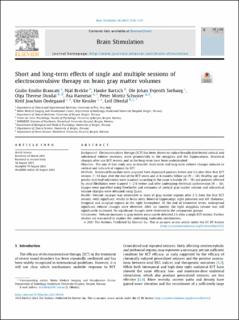Short and long-term effects of single and multiple sessions of electroconvulsive therapy on brain gray matter volumes
Brancati, Giulio Emilio; Brekke, Njål; Bartsch, Hauke; Sørhaug, Ole Johan Evjenth; Ousdal, Olga Therese; Hammar, Åsa Karin; Schuster, Peter Moritz; Ødegaard, Ketil Joachim; Kessler, Ute; Oltedal, Leif
Journal article, Peer reviewed
Published version

Åpne
Permanent lenke
https://hdl.handle.net/11250/2831691Utgivelsesdato
2021Metadata
Vis full innførselSamlinger
- Department of Clinical Medicine [2043]
- Registrations from Cristin [9489]
Sammendrag
Background: Electroconvulsive therapy (ECT) has been shown to induce broadly distributed cortical and subcortical volume increases, more prominently in the amygdala and the hippocampus. Structural changes after one ECT session and in the long-term have been understudied.
Objective: The aim of this study was to describe short-term and long-term volume changes induced in cortical and subcortical regions by ECT.
Methods: Structural brain data were acquired from depressed patients before and 2 h after their first ECT session, 7–14 days after the end of the ECT series and at 6 months follow up (N = 34). Healthy, age and gender matched volunteers were scanned according to the same schedule (N = 18) and patients affected by atrial fibrillation were scanned 1–2 h before and after undergoing electrical cardioversion (N = 16). Images were parcelled using FreeSurfer and estimates of cortical gray matter volume and subcortical volume changes were obtained using Quarc.
Results: Volume increase was observable in most of gray matter regions after 2 h from the first ECT session, with significant results in brain stem, bilateral hippocampi, right putamen and left thalamus, temporal and occipital regions in the right hemisphere. At the end of treatment series, widespread significant volume changes were observed. After six months, the right amygdala volume was still significantly increased. No significant changes were observed in the comparison groups.
Conclusions: Volume increases in gray matter areas can be detected 2 h after a single ECT session. Further studies are warranted to explore the underlying molecular mechanisms.
